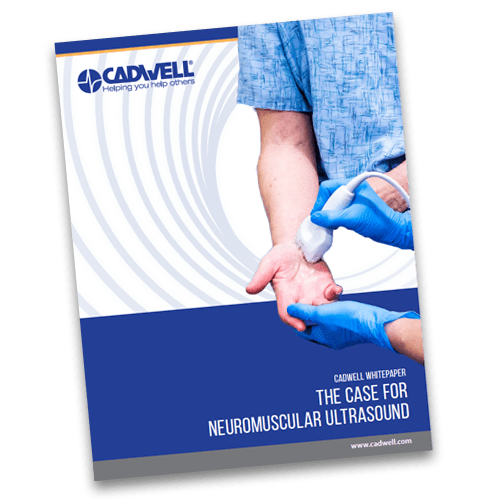Contact Us to SCHEDULE A DEMO
Chemodenervation Clinical Solutions
Ultrasound guidance for chemodenervation procedures
Improve instrumented guidance during chemodenervation procedures with direct and continuous ultrasound. Ultrasound helps visualize and select muscles or other structures for targeting, helps accurately localize the injection target to enhance effectiveness, and minimizes the potential risks and side effects. Color Doppler and Power Doppler help determine flow in vessels in the path to the target.
The goals during chemodenervation procedures are to accurately place the needle within the target structure, avoid structures in the needle path, and avoid structures adjacent to or behind the target structure. Electromyography (EMG), electrical stimulation, ultrasound guidance, and motor endplate targeting all help achieve these goals.
Benefits of needle guidance and e-stim during Chemodenervation
Traditionally guided by clinical examination and anatomic landmarks, the accuracy and safety of chemodenervation injections have been dramatically improved with ultrasound. Electrodiagnostic testing with Sierra Summit electrical stimulation and Sierra NMUS1 ultrasound may enhance the effectiveness of chemodenervation by:
- Visualizing and precisely locating muscles or other structures for targeting
- Accurately localizing the injection target
- Providing muscle activity information
- Minimizing potential risks by avoiding structures in the needle path, and structures adjacent to and behind the target
- Reducing the number of needle sticks
- Helping to place the needle in the target muscle or adjacent to the target nerve for motor point localization or nerve blocks
Using Sierra NMUS1 ultrasound for guided injections can help improve clinical outcomes, enhance patient safety, and save procedural time. Diagnostic, neurolytic, and anesthetic nerve blocks or motor point blocks are typical use cases for this combination, as well as for patients with complex postures associated with cervical or limb dystonia.
Clinical indications for ultrasound-guided needle injections
Combined techniques with Sierra electrodiagnostic solutions can be used to treat spasticity and function in individuals with spinal cord injuries, and to improve muscle activity in movement disorders like dystonia, tremors, and hemifacial spasms.
Clinical indications
*Notes FDA Approved Indications as of November, 2017. Cited from Ultrasound Guidance for Botulinum Neurotoxin Chemodenervation Procedures (2018) by Katharine E. Alter and Barbara I. Karp.
- Muscle Over-Activity (MoA) or Imbalance
- Bladder detrusor over-activity in patients with neurologic conditions*
- Blepharospasm*
- Bruxism
- Cervical Dystonia*
- Dystonic Tremor
- Essential Tremor
- Focal Limb Dystonia
- Lower Limb Spasticity, Adults and Pediatrics >2*
- Overactive Bladder
- Palatal Tremor
- Segmental Myoclonus
- Schwartz-Jampel Syndrome
- Strabismus*
- Task Tics
- Upper Limb Spasticity, adults*
- Upper Motor Neuron Syndromes
- Vocal Cord Dysfunction
Neuro-Secretory Disorders
- Frey Syndrome (Gustatory Sweating)
- Palmar Hyperhidrosis
- Plantar Hyperhidrosis
- Primary axillary hyperhidrosis*
- Sialorrhea
Urologic and Gynecologic
- Bladder Detrusor Over-activity in Patients with Neurologic Conditions*
- Bladder Outlet Obstruction
- Bladder Spasms and Pain
- Overactive Bladder*
- Sphincter Dyssynergy
- Urge Incontinence
Gastrointestinal
- Achalasia
- Rectal Fissure
Pain Conditions
- Cerebral Palsy postoperative pain and spasms
- Chronic Migraine*
- Cervical Dystonia pain associations
- Lateral Epicondylitis
- Lateral Epicondylosis
- Occipital Neuralgia
- Piriformis Syndrome
- Plantar Fasciitis
- Total Knee Arthroplasty postoperative pain
- Upper Motor Neuron Syndrome pain associations
“Ultrasound is a proven tool for guiding local anesthetic injections and soft tissue biopsies, so it is not surprising that ultrasound is also effective for guiding botulinum toxin injections.”
Cadwell Whitepaper: The Case for Neuromuscular Ultrasound
Recent developments in high-frequency ultrasound imaging technology have resulted in neuromuscular ultrasound (NMUS) becoming another important component of neurodiagnostic evaluations. Ultrasound can help diagnose common entrapment neuropathies and localize other nerve problems. Combined with EMG or NCS, you can increase your diagnostic certainty quickly, safely, and without patient discomfort.
Download materials, get software updates, and request hardware and software features
Shop for all the EMG electrodes and accessories you need
Explore Cadwell EDX products
The Sierra® family of products are the ideal solution for Chemodenervation, EMG, EPs, NCS, Ultrasound, and Electrodiagnostics in Urology.
Request an EMG, NCS, EP, and Ultrasound Demonstration
Product availability may vary between different countries and markets.
Please contact Cadwell for additional information.

